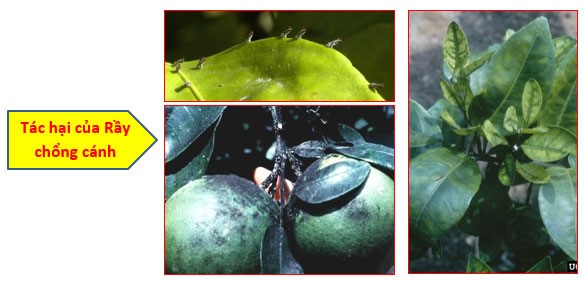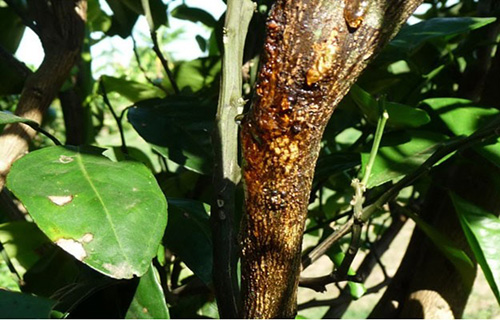|
ASIAN CITRUS PSYLLID (DIAPHORINA CITRI) DAMAGING CITRUS TREES
21/06/2023
ASIAN CITRUS PSYLLID (DIAPHORINA CITRI) DAMAGING CITRUS TREES Morphological characteristics: Adult is a small planthopper, with a body 2-3 mm long, the whole body is ash gray, slightly greenish, the wings are opaque with many small brown spots. Eggs are oval, 0.3 mm long, have a pointed end and are attached directly to the leaf surface, leaf axils.
Larvae are very small, oval in shape, newly hatched are bright yellow. Age 2 and age 3 are in green. Age 4 and age 5 are golden brown and 2 small wing sprouts.
Symptoms and effects: The larvae and adult larvae suck the sap of the leaves and young shoots, causing the young buds to fade, rough, and the damaged young leaves have small and curly leaf blades, affecting the growth and fruit yield. Sweet nectar secreted byplanthoppers is an environment for sootyfungi to grow, affecting photosynthesis of plants. Asian citrus psyllid is a common pest and is one of the most dangerous pests present on citrus trees in Vietnam and other countries because of the tramsmission of bacteria that cause yellow leaf disease with green veins.
Biological and ecological characteristics: * Life cycle: - Eggs: 4-6 days - Young caterpillars: 12 - 20 days - Mature: Can live more than 8 weeks. * After 4 - 5 days of maturation, start mating and laying. Eggs are laid in clusters on young shoots. A female lays about 200-800 eggs. * Adults usually suck on young , medium mature leaves, or along leaf veins. When eating, their wings are usually arranged on the back, the belly is like a roof, the head is down, the end of the abdomen is raised up to form an angle of 30-400 compared to the leaf surface. * Adults are often attracted to yellow and brown colors. * Trees that produce buds all year round are often severely damaged. It is not recommended to plant ornamental plants of the citrus family such as Nguyet Quoi, Can Thang, Kim Quyt... near lemon, orange, and tangerine gardens. Pruning branches, fertilizing, watering ... control the bursts of buds to focus to limit the growth and harm of leafhoppers. Uprooting the greening diseased plants in the garden and destroy them to reduce the source of the disease from spreading to healthy trees. Plant windbreaks around the garden to limit the movement of planthoppers. Use yellow sticky traps to monitor for planthoppers. Protect and create conditions for the development of natural enemies in the garden (parasitic bees, weaver ants...). Spraying when the plants are young, can be used with products: Sagometro 50WG, Schezgold 500WG, Sairifos 585EC combined with Butyl 10WP, 400SC…, or Sairifos 585EC with SK EnSpray 99EC Mineral Oil.
|
To prevent, in addition to plowing and burying weed seeds, collecting weed stalks and stumps left after tilling the land to burn, not letting weeds produce seeds in production fields, etc., the use of chemical products is still a measure. optimal because of its ability to thoroughly kill weeds, reduce labor and take advantage of more time than manual weeding.
Miner has the scientific name Phyllocnistis citrella Staint., family Phyllocnistidae, order Lepidoptera. The miner occurs in many countries in the tropics and subtropics. The main host of the miner is the citrus family - Rutaceae. In addition, the miner also attacks mangosteen and some other plants.
Green bugs specialize in the fruit of citrus groups (oranges, tangerines, lemons, grapefruits, kumquats...), some people call them orange bugs, or orange suckers. Their scientific name is Rhynchocoris poseidon or Rhynchocoris humeralis.
In Vietnam, yellow leaf curl disease is very common on papaya trees, especially the disease is often severe in areas of high and continuous planting, areas with hot and arid climates. The disease has significantly reduced the yield and quality of papaya. Gardens that are infected early when the plants are young may not yield. However, up to now, many gardeners still do not know the cause and how to fix it.
Spider mites are common pests on citrus trees, especially in hot and dry climates that are suitable for spiders to grow and cause severe damage.The group of harmful spiders is usually very small in size, unlike the natural enemy spiders.
This group includes species that are generally very small in size, causing damage by sucking plant sap (on leaves, fruits, branches, stems).
There are many species of mealybugs present on the group of Oranges,Tangerines,Grapefruits and Lemons (Citrus), which can be divided into 2 groups:
+ Group of sticky mealybugs with common varieties such as Lepidosaphes, Aonidiella, Coccus and Saissetia.
+ Group of flower mealybugs with common genera and species such as Pseudococcus, Planococcus and Icerya purchasi.
Dry branches and berries disease often appear to be common damage on coffee gardens during the rainy season. The disease causes death of branchs, dry fruit, severely affects the canopy structure and coffee yield if not paid attention to prevention.
Pink disease commonly causes diseases on rubber plantations in the rainy season, especially on garden from 4-8 years old. This year, rubber has to go through a period of severe drought, weakening the tree, so now in tnshe rainy season it is easy to get infected. Therefore, it is necessary to pay attention to good management to avoid affecting the garden.
In recent years, the area of citrus has been expanded because it is a fruit tree with high economic efficiency. However, in order to sell at a high price, not only in quality but consumers also require the external beauty of the fruit, so pest management on citrus is a matter of great concern to farmers. The hot season is a favorable condition for thrips to develop and cause damage, affecting the commercial value of fruit.
Currently in Vietnam, the cultivation of citrus trees is playing an important role in the country agricultural production. The benefits of citrus trees have made many farmers rich. However, wherever citrus trees are planted, fissured trunk cracking appears and causes damage. If any gardener is negligent or lacks attention to this disease, the tree will die, even the whole garden.
- Headquarters
- SAIGON PLANT PROTECTION JOINT STOCK COMPANY
- RQ 1, Nguyen Van Quy St., Tan Thuan Ward, HCM City
- Tax code: 0300632232
- Tel: (028) 38 733 295 - 38 732 077
- Fax: (028) 38 733 003 - 38 733 391
- Website: www.spchcmc.vn - Email: info@spchcmc.vn
- SAIGON PLANT PROTECTION COMPANY
- SAIGON PLANT PROTECTION JOINT STOCK ENTERPRISE
- Lot C1-C3 Hiep Phuoc Industrial Park, Hiep Phuoc Commune, HCM City
- Tel: (028) 3873 4089 - Fax: (028) 3873 4086
- Affiliated Unit
-
- Quick Links
- Home
- About us
- Career Opportunities













